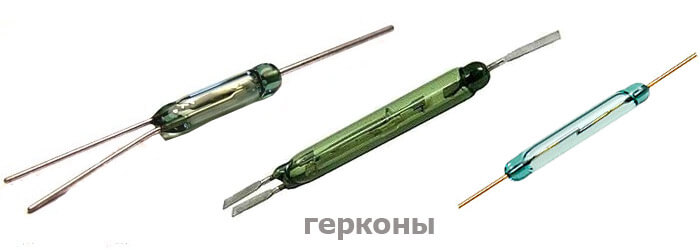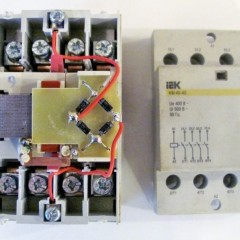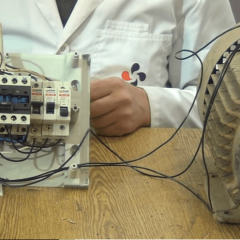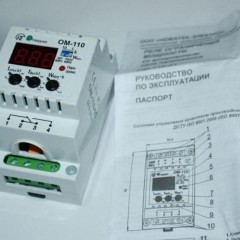What are reed switches, how are they arranged and work?
What it is?
Today, reed switches are practically not used, since Hall sensors appeared. But still, in some cases, these products are indispensable. They are easy to use, and this serves as the fact that they are still used in various types of circuits or devices.
If reliability and durability are needed, then this part is irreplaceable by anything. Where is the switch used? It can be included in the design of the sensor, electronic relays and other devices.
Reed switches, like other devices or their parts, are divided into various types.
By function:
- short circuit;
- switching;
- opening.
Design and technical features:
- Dry contact (without any secrets, it works according to the principle described below).
- Mercury contact (mercury drops are added to the contact in a glass case, which wet them when the reed switch is activated, which improves the quality of the contact. This also avoids contact bounce (vibration), which increases the response time.
Based on this, it is better to use mercury contact, but this is not at all points.
Design Features
The design of the reed switch is a sealed glass cylinder, inside of which there are contacts. These contacts are magnet cores that are welded to the ends of the bulb. The external parts of these cores are connected to the mains. The diagram below shows the device design:
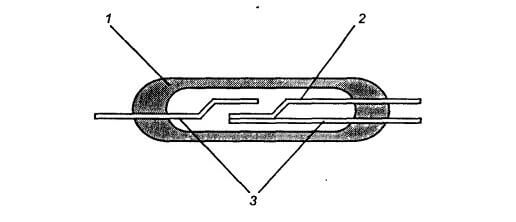 Where:
Where:
- Glass flask.
- Switching contact.
- Fixed contact.
The most common are reed contact sensors. Rectangular ferromagnetic wire contacts. Depending on the power and size of the reed switch, the cores are made of permalloy wire. Also, the coating can be replaced with other metals (gold, silver, rhodium and others).
An inert gas is launched into the flask or evacuated, which prevents the development of corrosion in the reed switch. In the manufacture of the part, it is also taken into account that there is a gap of a certain size between the cores.
How does a reed switch work?
The contact group will come into effect only if there is a certain magnetic field voltage around the reed switch, which is created in any way, be it constant or electromagnetic. The principle of operation is that the cores inside the bulb are magnetized, attracted to one another and this closes the circuit.All this will be in effect until the disappearance of the magnetic field. Further operations also depend on the presence of a magnetic field around the reed switch.
The principle of operation of the magnetic sensor for opening works a little differently. In the presence of a magnetic field, the contacts are magnetized by the same name and are repelled from each other, which opens the circuit.
Switching reed switch in a magnetic field: closes open contacts, and the non-magnetic contact remains as it was before.
You can clearly see how the reed switches work, you can in the video below:
The breakdown voltage of devices can grow up to 5 kV. The sensor works in 0.5-2 ms, and turns off in 0.1-0.7 ms, and this is much less than, for example, the operation of an electromagnetic relay.
Purpose and scope
Reed switches are used to this day in:
- keyboards and synthesizers;
- safety and automation equipment;
- scuba diving equipment;
- equipment for testing and taking measurements;
- equipment in medical facilities and communication devices.
For example, reed switches are used as a relay in security systems. The devices are also used in the security sensor. From itself it represents: a reed switch plus a magnet. If we consider a reed relay, then it is: a reed switch and a wire winding. The advantages of such a relay are:
- small size and simplicity of design;
- not amenable to moisture and burning contacts;
- no moving elements.
You can apply such details a lot in what and where. But one significant drawback is the low impact resistance, and this is very important for various systems, sensors, etc.
Pros and cons of fixtures
The use of reed sensors gave both positive and negative points:
- design to reduce size;
- quick response and shutdown;
- completely sealed cores;
- dielectric strength between contacts;
- long service time (excluding blows);
- Reed switch works in all weather conditions from -60 to +120 degrees.
- low impact resistance;
- perception of external magnetic fields;
- low power when switching a circuit;
- random opening at high current;
- Sometimes short-circuiting and opening may occur arbitrarily.
Application Tips
If you need to use reed switches, then consider the following nuances of application:
- Ultrasound must be avoided, as it can affect and alter electrical characteristics.
- When installing, remember that the magnetic field can change the characteristics of the circuit breaker.
- It is forbidden to hit and drop the reed switches, as due to inert gas, which breaks up upon impact, the balloon may burst, which will damage the device.
- Follow the manufacturer's recommendations when soldering.
Specifications
All technical characteristics of the main types of reed switches are shown in the table below:
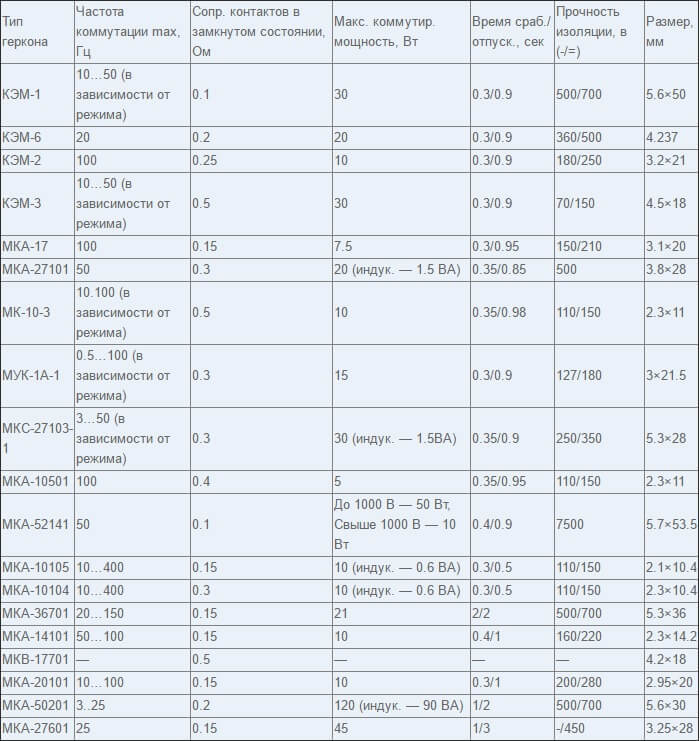
The marking of the reed switches depends on the area in which they operate. Each of the existing abbreviations means something (for example, KEM - switching of electrical mechanisms, A - work in any climatic conditions, B - work only indoors). When choosing, you must consider these nuances.
You can find switches in electrical stores, on radio markets, or order on the Internet. If you need a reed switch for a car, then you can purchase it at a car service. It is also possible to make the reed switch yourself, but this requires expensive equipment.
So we examined the technical characteristics of the reed switches, as well as their operating principle and scope. We hope that now it has become clear to you what these switches are and what they are used for.
It will be useful to read:

